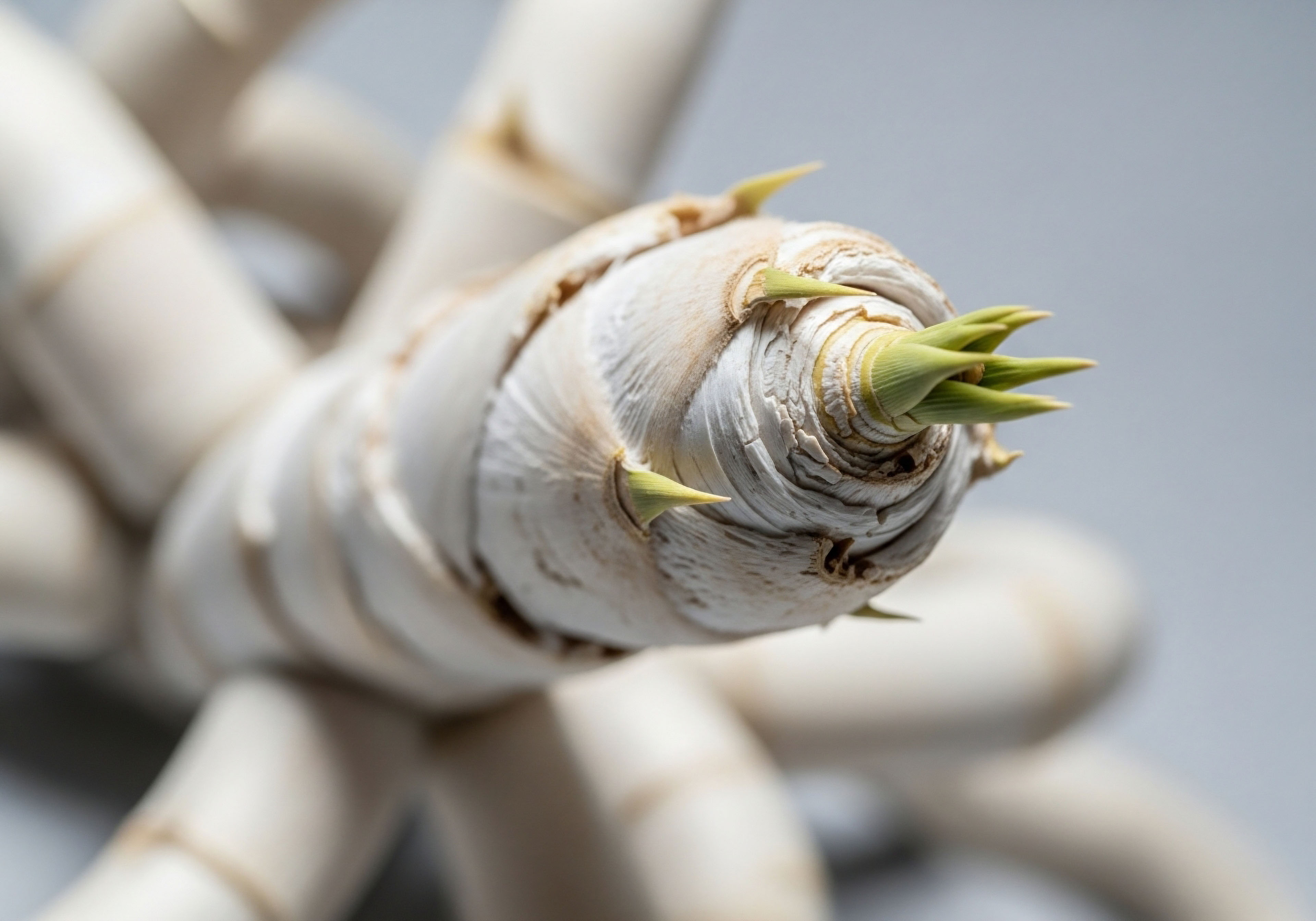

Fundamentals
You feel it before you can name it. A subtle shift in energy, a change in your sleep, a new pattern in your mood or metabolism that you cannot quite pinpoint. For decades, the only tool to investigate these feelings has been a single snapshot in time a blood test.
This test, while valuable, captures your hormonal state on one particular morning, a single frame from the complex, dynamic film of your life. Your body, however, operates as a continuous, flowing conversation. Hormones are the language of this conversation, rising and falling in intricate rhythms throughout the day and month, responding to every meal, every stressor, every moment of rest. Understanding this language requires listening to the entire dialogue, not just a single, isolated word.
The journey into your own biology begins with acknowledging this dynamic reality. The fatigue that clouds your afternoon, the unexplained weight gain, or the frustrating changes in your cycle are not isolated events. They are data points in a larger pattern, expressions of an internal system working to maintain balance.
The frustration many feel comes from the disconnect between their lived experience and the “normal” result on a lab report. This is where a new generation of technology is beginning to change the conversation entirely. We are moving toward tools that can map the fluctuations of your internal world in real time, providing a high-resolution picture of your unique hormonal signature.
True hormonal insight comes from observing the dynamic patterns of your biology, not just a single, static measurement.
This evolution in monitoring is about transforming data into self-knowledge. When you can see the direct impact of a stressful meeting on your cortisol levels or track the precise ebb and flow of progesterone across your cycle, your health becomes a proactive collaboration with your own body.
You gain the ability to connect your actions and environment to your internal state with unprecedented clarity. This is the foundational principle of personalized wellness ∞ equipping you with the information to understand your own system, so you can learn to support its function and reclaim your vitality. The goal is to move from guessing to knowing, from reacting to symptoms to proactively cultivating balance.


Intermediate
To capture the continuous dialogue of the endocrine system, we must develop methods that go beyond the vein. The standard blood draw provides a crucial, yet limited, perspective. Emerging technologies are built upon two core advancements ∞ accessing new sources of biological information and developing hyper-sensitive tools to analyze them. This allows us to see the subtle, moment-to-moment shifts that define hormonal health.

New Frontiers in Biological Sampling
The body offers several windows into its hormonal state. While blood is the primary transport medium, hormones and their metabolites are present in other accessible biofluids. Innovators are focused on these alternatives to create a less invasive and more continuous monitoring experience.
- Sweat A surprising wealth of biomarkers, including steroid hormones like cortisol, can be detected in sweat. As you perspire, trace amounts of these molecules are carried to the surface of the skin, offering a non-invasive source for real-time analysis through wearable patches.
- Saliva For years, researchers have used saliva to measure hormones like cortisol and progesterone. Salivary concentrations reflect the “free,” bioavailable portion of a hormone, which is the amount that can actively engage with cellular receptors. New at-home kits use this principle for daily fertility and stress tracking.
- Interstitial Fluid (ISF) This is the fluid that bathes our cells, acting as a crucial intermediary between blood capillaries and tissues. Accessing ISF with minimally invasive microneedles provides a highly relevant picture of what hormones are being delivered to cells at that very moment, creating a data stream that is exceptionally close to real-time cellular activity.

The Technology of Translation from Molecule to Data
Once a sample is accessed, the core challenge is to detect hormone concentrations that can be incredibly low, sometimes measured in picograms per milliliter. This requires a sophisticated sensor system composed of two key parts ∞ a recognition element and a transduction element.

Recognition the Molecular Lock and Key
To measure a specific hormone, the sensor must first isolate it from the thousands of other molecules in a biofluid. This is achieved using highly specific binding agents.
A primary tool for this is the aptamer, a sequence of synthetic, single-stranded DNA or RNA. Through a process of guided evolution in the lab, aptamers can be designed to fold into a precise three-dimensional shape that binds exclusively to a target hormone. Their stability and consistency make them ideal for use in reusable or continuous sensors.

Transduction Converting Biology into Signal
After a hormone molecule binds to its recognition element, the sensor must convert that biological event into a measurable signal. The most common method in emerging wearables is electrochemical detection.
In this process, the sensor’s surface is an electrode coated with aptamers. When the target hormone binds to the aptamers, it changes the electrical properties at the surface of the electrode, such as its impedance or current flow. This change is proportional to the amount of hormone present. A tiny integrated chip measures this electrical fluctuation and translates it into a digital data point that can be sent to a smartphone or other device.
Wearable biosensors work by pairing a highly specific molecular “trap” with an electronic transducer that converts the biological event of binding into a digital signal.
| Feature | Traditional Blood Test | Emerging Wearable Biosensor |
|---|---|---|
| Invasiveness | Invasive (venipuncture) | Non-invasive (sweat) or minimally invasive (microneedle) |
| Monitoring Frequency | Single point-in-time | Continuous or high-frequency (every 1-5 minutes) |
| Data Output | Static value (e.g. ng/dL) | Dynamic trendline, fluctuation patterns, daily rhythms |
| Biofluid Measured | Blood serum/plasma | Sweat, Saliva, or Interstitial Fluid |
| Primary Application | Diagnosis of established conditions | Personalized wellness, fertility tracking, stress management, protocol optimization |


Academic
The convergence of materials science, nanotechnology, and bioengineering is driving the development of sophisticated platforms for hormonal analysis. Among the most promising of these are minimally invasive systems using microneedle arrays to sample dermal interstitial fluid (ISF).
These devices represent a significant leap in physiological monitoring, offering access to a biofluid that provides a high-fidelity reflection of the metabolic and endocrine state at the tissue level. Their potential lies in their ability to generate continuous, dynamic data streams that were previously only obtainable in highly controlled research settings.

The Promise of Interstitial Fluid a Window into Real-Time Physiology
Dermal ISF is the reservoir of fluid that surrounds the cells of the dermis, facilitating the transport of nutrients, signaling molecules, and waste products between the vasculature and the cells themselves. Its composition closely mirrors that of blood plasma for many small molecules, including steroid hormones and glucose.
Sampling ISF offers two distinct advantages over traditional venipuncture. First, it is a minimally invasive procedure, as microneedles are designed to penetrate the stratum corneum and enter the viable epidermis without reaching the nerve endings and blood vessels of the deeper dermis. Second, ISF provides a more immediate picture of the hormonal environment experienced by the cells, capturing fluctuations with a higher temporal resolution than blood, which represents a systemic average.

Engineering the Sensor Interface the Synergy of Microneedles and Aptamers
A functional microneedle-based hormonal sensor is a complex, multi-component system. The physical architecture involves an array of microscopic needles, typically fabricated from biocompatible polymers or silicon, attached to a small, flexible patch. These needles can be designed in several configurations to interface with the ISF.
| Microneedle Type | Mechanism of Action | Application in Hormone Monitoring |
|---|---|---|
| Solid Microneedles | Create temporary micropores in the skin to increase permeability for a subsequent patch or for biomarker extraction. | Primarily used to pre-treat the skin to facilitate ISF sampling onto a separate sensing membrane. |
| Coated Microneedles | The needles are coated with a substance (e.g. a recognition molecule) that dissolves into the skin upon insertion. | Less common for monitoring, more suited for drug delivery. Can be adapted for single-point competitive binding assays. |
| Hollow Microneedles | Contain a micro-channel that allows for the continuous extraction of ISF via capillary action or a micro-pump. | The extracted ISF is channeled to an integrated biosensor for real-time analysis, enabling a continuous data stream. |
| Hydrogel Microneedles | Made of a porous, swelling polymer that absorbs ISF. The target hormone becomes concentrated within the hydrogel matrix. | The patch is worn for a period, then removed for analysis. It provides an integrated measurement over time. |
For continuous monitoring, hollow microneedles integrated directly with an electrochemical biosensor are the most advanced configuration. The surface of the electrochemical sensor, located within the device, is functionalized with highly specific aptamers designed to bind to the target hormone (e.g. cortisol or progesterone).
As ISF flows through the hollow needle and over the sensor, hormone molecules are captured by the aptamers. This binding event modulates an electrical signal (e.g. impedance), which is measured and correlated to hormone concentration. Nanomaterials, such as carbon nanotubes or gold nanoparticles, are often incorporated into the electrode surface to amplify this signal, providing the sensitivity required to detect picomolar concentrations.

How Can We Ensure Sensor Reliability over Time?
The translation of these technologies from laboratory prototypes to reliable clinical and consumer devices faces significant hurdles. The primary challenge is ensuring sensor stability and accuracy over extended periods of use (hours to days). The biological environment is harsh; biofouling, the process by which proteins and other molecules adhere to the sensor surface, can degrade signal quality and accuracy.
Researchers are actively developing anti-fouling coatings and advanced calibration algorithms that use multi-signal measurements to correct for sensor drift in real time.
The long-term reliability of in-situ biosensors depends on solving the complex challenges of biofouling and real-time calibration within a dynamic biological environment.
Furthermore, the correlation between hormone concentrations in ISF and blood must be rigorously established for each specific hormone and device. While a strong correlation exists for many analytes, factors like metabolic clearance rates in the tissue and transport kinetics can influence the relationship.
Extensive clinical validation studies are required to establish the precise algorithms that can translate a raw sensor signal from ISF into a clinically meaningful data point. Finally, the vast amount of high-frequency data generated by these devices requires sophisticated analytical software, potentially using machine learning, to extract actionable insights, identify meaningful trends, and avoid overwhelming the user with raw data.

References
- Wang, Chun-Wei, et al. “Toward At-Home and Wearable Monitoring of Female Hormones ∞ Emerging Nanotechnologies and Clinical Prospects.” ACS Sensors, 2024.
- “Hormone Intelligence ∞ The New Frontier of Biomarker Tracking.” Coyote Ventures, 9 May 2025.
- “Toward At-Home and Wearable Monitoring of Female Hormones ∞ Emerging Nanotechnologies and Clinical Prospects.” PubMed, National Center for Biotechnology Information, 24 Jan. 2025.
- “Wearable Technology for Monitoring Hormonal Health.” MoldStud, 26 Apr. 2024.
- Ghavami, Reza, et al. “Microneedle-Based Device for Biological Analysis.” Frontiers in Bioengineering and Biotechnology, vol. 10, 2022.
- “Researchers invent new method for developing accurate sensors for continuous health monitoring.” ScienceDaily, 14 Mar. 2025.
- Torrente-Rodríguez, R. M. et al. “Wearable electrochemical biosensors to measure biomarkers with complex blood-to-sweat partition such as proteins and hormones.” Analytical and Bioanalytical Chemistry, vol. 414, no. 2, 2022, pp. 689-700.
- “Microneedle biosensor and remote monitoring system for hormone treatment.” InnoUA, University of Alicante.
- Whitten, T. A. et al. “Recent advances in noninvasive techniques to monitor hormone-behavior interactions.” American Journal of Physical Anthropology, vol. 107, S27, 1998, pp. 1-23.
- “Advances in Non-Invasive Hormone Monitoring.” Arbor Assays, 17 July 2020.

Reflection
The information presented here represents a profound shift in how we can relate to our own bodies. The ability to observe the intricate, real-time dance of our internal chemistry is more than a technological achievement; it is an invitation.
It is an invitation to become a more astute observer of your own life, to connect the choices you make with the way you feel on a biological level. This knowledge is the first step. The next is to ask what it means for you.
How might a deeper understanding of your personal rhythms change the way you structure your day, your nutrition, or your response to stress? The path to sustained vitality is deeply personal, and these tools are simply a more detailed map. The journey itself, and the wisdom gained along the way, belongs entirely to you.



